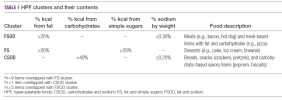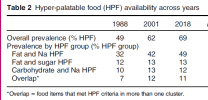Eddy Edson
Well-Known Member
- Relationship to Diabetes
- Type 2
Chris MacAskil has a new vid which I found interesting mainly for its focus on the work of Tera Fazzino, a young nutrition researcher who has become a collaborator with Kevin Hall on some important food studies.
Fazzino's main thing has been developing a precise, quatitive definition for "hyper palatable food" (HPF). See https://onlinelibrary.wiley.com/doi/abs/10.1002/oby.22639
The focus is not on individual nutrients but combinations. It overlaps with but is not the same as the "ultra processed food" concept. A food can be UPF without being HPF, and HPF is possibly a better policy target. UPF is here to stay - cheap, convenient, shelf-safe, tasty - but realistically you can actually do something about HPF. And palatability appears to be an actual obesity driver; not necessarily the case for UPF.
In summary, using "data driven methods" she divides HPF into three threshhold categories: Fat plus sodium; fat plus sugars; carbs plus sodium.

See the paper for a discussion of validation.
With this definition, a huge 69% of foods in the standard US database are now HPF's. By standard food categories:

Another paper looked at how this has evolved over time. https://pubmed.ncbi.nlm.nih.gov/35581172
Results: The prevalence of HPF increased 20% from 1988 to 2018 (from 49% to
69 %; P < 0·0001). Themost prominent differencewas in the availability of HPF high
in fat and Na, which evidenced a 17% higher prevalence in 2018 compared with
1988 (P < 0·0001). Compared with 1988, the same food items were >2 times more
likely to be hyper-palatable in 2001, and the same food items were >4 times more
likely to be classified as hyper-palatable in 2018 compared with 1988 (P values
< 0·0001).
Conclusions: The availability of HPF in the US food system increased substantially
over 30 years. Existing food products in the food system may have been reformulated
over time to enhance their palatability.
Most of the huge increase from 1988-2018 (from 49% to 69% of food supply) has been in the FSOD (fat + sodium) category. Fat+sugars and carbs+sodium didn't change much:

Underlying the change:
[Fat + sodium HPF foods] commonly consists of meal-based items and savory
foods(14,18) and the findings may reflect the increase of frozen
foods and quick preparation items that were introduced
to the food system in the 1980s(6,31). Relatedly, our
analyses indicated that foods from the USDA-defined categories
of fats, meats and dairy, foods that are commonly
frozen or quick-preparation foods, yielded escalating
increases in their likelihood of being hyper-palatable over
the 30-year period.
Fazzino believes that the increase likely reflects a deliberate program by food companies to increase palatability. On the other hand, it suggests a plausible policy strategy.
The current US food supply is highly saturated with HPF, which our findings
indicate comprised almost 70 % of available foods as of
2018. The growing availability of HPF over time, particularly
HPF high in fat and Na, may have resulted from the
reformulation of existing food products in the food system
to be hyper-palatable. Thus, expanding HPF availability
may be one key contributor to the obesogenic food environment
in the US. Given potential consequences for population
health, policy-level action is needed to address the
presence of HPF in the food system. Policy may focus on
limiting the nutrient thresholds allowed in foods to be
below HPF thresholds (e.g. foods should contain <25 %
kcal from fat and <0·30 % g from Na). The approach would
be beneficial and highly feasible as it could largely decrease
the availability of HFP in the food system and would not
require the removal ofHPF items from the food system altogether
(which would be infeasible). Given that reformulation
of food products to enhance their palatability may be a
key strategy employed by US food companies, policy
action targeting nutrient combinations in individual foods
may be the most necessary and direct approach to regulating
the presence of foods in the food environment that may
be difficult to stop eating.
Fazzino's main thing has been developing a precise, quatitive definition for "hyper palatable food" (HPF). See https://onlinelibrary.wiley.com/doi/abs/10.1002/oby.22639
The focus is not on individual nutrients but combinations. It overlaps with but is not the same as the "ultra processed food" concept. A food can be UPF without being HPF, and HPF is possibly a better policy target. UPF is here to stay - cheap, convenient, shelf-safe, tasty - but realistically you can actually do something about HPF. And palatability appears to be an actual obesity driver; not necessarily the case for UPF.
In summary, using "data driven methods" she divides HPF into three threshhold categories: Fat plus sodium; fat plus sugars; carbs plus sodium.

See the paper for a discussion of validation.
With this definition, a huge 69% of foods in the standard US database are now HPF's. By standard food categories:

Another paper looked at how this has evolved over time. https://pubmed.ncbi.nlm.nih.gov/35581172
Results: The prevalence of HPF increased 20% from 1988 to 2018 (from 49% to
69 %; P < 0·0001). Themost prominent differencewas in the availability of HPF high
in fat and Na, which evidenced a 17% higher prevalence in 2018 compared with
1988 (P < 0·0001). Compared with 1988, the same food items were >2 times more
likely to be hyper-palatable in 2001, and the same food items were >4 times more
likely to be classified as hyper-palatable in 2018 compared with 1988 (P values
< 0·0001).
Conclusions: The availability of HPF in the US food system increased substantially
over 30 years. Existing food products in the food system may have been reformulated
over time to enhance their palatability.
Most of the huge increase from 1988-2018 (from 49% to 69% of food supply) has been in the FSOD (fat + sodium) category. Fat+sugars and carbs+sodium didn't change much:

Underlying the change:
[Fat + sodium HPF foods] commonly consists of meal-based items and savory
foods(14,18) and the findings may reflect the increase of frozen
foods and quick preparation items that were introduced
to the food system in the 1980s(6,31). Relatedly, our
analyses indicated that foods from the USDA-defined categories
of fats, meats and dairy, foods that are commonly
frozen or quick-preparation foods, yielded escalating
increases in their likelihood of being hyper-palatable over
the 30-year period.
Fazzino believes that the increase likely reflects a deliberate program by food companies to increase palatability. On the other hand, it suggests a plausible policy strategy.
The current US food supply is highly saturated with HPF, which our findings
indicate comprised almost 70 % of available foods as of
2018. The growing availability of HPF over time, particularly
HPF high in fat and Na, may have resulted from the
reformulation of existing food products in the food system
to be hyper-palatable. Thus, expanding HPF availability
may be one key contributor to the obesogenic food environment
in the US. Given potential consequences for population
health, policy-level action is needed to address the
presence of HPF in the food system. Policy may focus on
limiting the nutrient thresholds allowed in foods to be
below HPF thresholds (e.g. foods should contain <25 %
kcal from fat and <0·30 % g from Na). The approach would
be beneficial and highly feasible as it could largely decrease
the availability of HFP in the food system and would not
require the removal ofHPF items from the food system altogether
(which would be infeasible). Given that reformulation
of food products to enhance their palatability may be a
key strategy employed by US food companies, policy
action targeting nutrient combinations in individual foods
may be the most necessary and direct approach to regulating
the presence of foods in the food environment that may
be difficult to stop eating.

